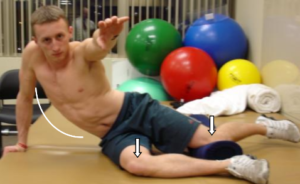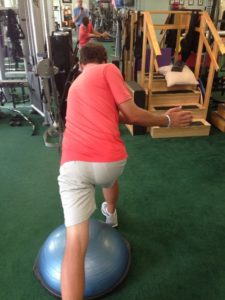By Chris Poulin
Attaining Effective Sidebend Ranges
Among the golf professionals with whom I’ve worked, it’s widely accepted that there needs to be some side-bending of the upper body at the top of the backswing. But why?
Without side-bending the movement would be similar to hitting a baseball off a tee. The amount of necessary side-bending, however, can vary depending on the shaft length of the club that you are swinging. For example, you would expect to see an increase in side-bending with a pitching wedge, and a decrease with a driver.
In the golf fitness industry, the amount of side-bending that we try to achieve is around 40 degrees. We use this number to create programs that are functional in developing rotary speed and power, but its reduction to a single target is also to some degree arbitrary. That is, K-VEST states that the average tour pro has a sidebend range of 39 to 45 degrees when hitting with a 6-iron. When training golfers, then, it would behoove us to look at human form and function in order to help them attain this position safely and efficiently.
What Biomechanical Analysis Reveals
In the images below you can see a compensatory position that most amateurs experience; it is termed a “flat shoulder plane,” and one can contrast it with the professional golfer shown on the right who is side-bending into an acceptable range. Anecdotally, I find that golfers with limited upper body sidebend have increased right sided lower back pain as a result of their right quadratus lumborum staying hypertonic.
Flat Shoulder Plane vs. Ideal Shoulder Plane
This type of movement is particularly challenging for right-handed players who, because of the normal asymmetrical form of the thorax and neurologic systems, are patterned to favor their right sides and want to maintain right side bending throughout the swing. So correcting any problems is not as simple as asking the golfer to achieve an optimum number—and voila!
The abdominal muscles of a golfer (as shown in the anatomical cross-section) are asymmetrical in their roles in the golf swing; couple that with the fact that the diaphragm muscle is bigger and happens to attach one vertebrae lower on the right, and you have a very good explanation for why we see right shoulders lower than left shoulders with right-handed players.
Above you can see the abdominal area of two golfers, an amateur on the left and a professional on the right. Notice the difference in the right sides vs. the left sides, and check yourself in the mirror. If your left arm is farther away from your side and your right shoulder is lower than your left, the exercises that follow could help you achieve a better sidebend position at the top of your golf swing.
Objective Evidence and Practical Exercises
Using K-VEST, we can capture upper body sidebend data and train our clients how to become better at stretching their right abdominal wall and strengthening their left. Below you can review a typical finding for a patterned right-handed golfer. Take note of the upper body sidebend at the top and understand that, again, our goal would be to achieve around 40 degrees. The exercises that follow (reprinted with permission from the Postural Restoration Institute) will help you reach that.
Right Side Stretches
 Lie on your right side with your right leg bent at a 90-degree angle.
Lie on your right side with your right leg bent at a 90-degree angle.
Lunge With Low Guard
 Place your left knee on a 6-10 inch block, and your right leg in front of the block with your knee and hip bent and your foot flat.
Place your left knee on a 6-10 inch block, and your right leg in front of the block with your knee and hip bent and your foot flat.
Note: When performing with K-VEST, aim for 40 degrees of upper body sidebend and 50 degrees of rotation over a stable pelvis.
 Chris Poulin is a certified athletic trainer and strength and conditioning specialist with over 20 years experience. He maintains certifications with the NSCA, PRI, NATA, NASM and TPI; he is also a member of the first class of certified athletic trainers to be recognized by the Postural Restoration Institute and earning the PRT credential. A co-owner of Sandhills Sports Performance in Southern Pines North Carolina, he specializes in athletic development and reconditioning.
Chris Poulin is a certified athletic trainer and strength and conditioning specialist with over 20 years experience. He maintains certifications with the NSCA, PRI, NATA, NASM and TPI; he is also a member of the first class of certified athletic trainers to be recognized by the Postural Restoration Institute and earning the PRT credential. A co-owner of Sandhills Sports Performance in Southern Pines North Carolina, he specializes in athletic development and reconditioning.
The MLB Winter Meetings brings together baseball executives, coaches, media, exhibitors and job seekers from around the world to network, fill job openings, attend educational workshops and discuss innovating trends in the industry. It’s one of the highlights of our…
Agreement to Accelerate Improvement Across All Levels of the Organization (SCOTTSDALE, Ariz.) K-MOTION – the leader in 3D evaluations and biofeedback training solutions for coaches and athletes – announces an agreement with the Baltimore Orioles to become the organization’s Player…
By Joe DiChiara and Jason Meisch You take a swing and don’t like where the golf ball goes. You want to know what happened, so you turn to your launch monitor. You look at the club face numbers. They tell…